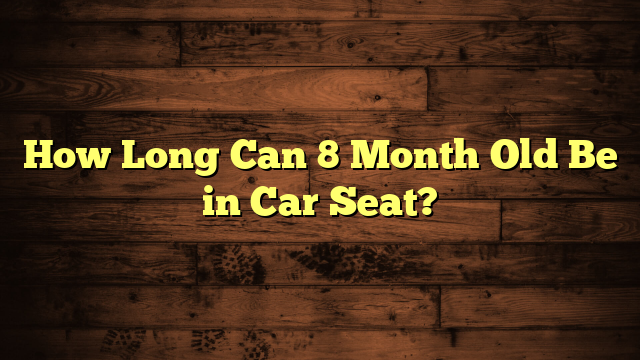What Side Should a Car Seat Be On?
When you think about the convenience of accessing a car seat versus the safety of your child, the choice of which side to place it on becomes more complex. While the passenger side offers easier entry, the driver's side can enhance your ability to monitor your child during trips. Each option presents distinct advantages and considerations that can impact not only safety but also daily routines. Understanding these factors is essential, especially when you factor in the dynamics of your family vehicle and real-life scenarios. What's the best approach for your situation?
Key Takeaways
- The back seat is the safest location for a car seat, especially for children under 13 years old.
- Placing the car seat in the center position maximizes distance from potential impact zones.
- The passenger side offers easier access for loading and unloading children, especially in tight spaces.
- The driver's side allows for better visibility and interaction with the child during travel.
- Consider local traffic conditions and choose the side that minimizes exposure to oncoming traffic.
Importance of Car Seat Placement
Car seat placement is essential for your child's safety on the road. You mightn't realize it, but where you position your car seat can greatly impact your child's protection during a crash. Following car seat regulations is important, as they're designed to keep your little one safe.
Typically, the back seat is the safest spot for any child under 13. It's recommended to install the car seat in the center if possible, as this position provides the most distance from potential impact zones.
However, if the center seat isn't an option due to your vehicle's design, the side seats can also work well, particularly the passenger side, as it allows for easier access when loading and unloading your child.
Always verify your car seat is properly secured and that you're using it according to the manufacturer's instructions. Regularly check that your child is still within the weight and height limits specified in the car seat regulations.
Pros of the Driver's Side
When considering car seat placement, the driver's side can offer several advantages that make it a practical choice for parents. One of the main benefits is improved driver visibility. By placing the car seat on the driver's side, you can easily monitor your child in the rearview mirror without having to turn your head as much. This positioning helps you keep your child in view while driving, enhancing safety.
Another advantage is increased child interaction. When your child is seated on the driver's side, you can engage with them more easily during trips. Whether you're singing songs, playing games, or simply chatting, this proximity can strengthen your bond.
Here's a quick comparison of the pros of the driver's side:
| Pros | Benefits | Considerations |
|---|---|---|
| Driver Visibility | Easier monitoring of the child | Possible distractions |
| Child Interaction | More engagement during travel | Requires focus while driving |
| Convenient Access | Easier to buckle/unbuckle | May limit passenger space |
Ultimately, choosing the driver's side can enhance both safety and connection during your journeys.
Pros of the Passenger Side
Placing the car seat on the passenger side offers several benefits that can enhance your travel experience. First and foremost, it allows for easier access when getting your child in and out of the car. You won't have to navigate around the driver's door, which can be especially helpful in tight parking spaces. This convenience can also contribute to child comfort, as you can quickly attend to your little one's needs without unnecessary hassle.
Additionally, positioning the car seat on the passenger side can improve passenger safety. In many cars, the passenger side airbag can be turned off when a car seat is installed, reducing the risk of injury in an accident. This feature allows you to ascertain that your child is as safe as possible during your travels.
Moreover, being on the passenger side means your child is less exposed to oncoming traffic, which can be comforting for both you and your little one.
Safety Considerations
When choosing which side to place your car seat on, safety should be your top priority.
Consider factors like side impact protection, which can vary considerably between the driver and passenger sides.
You'll also want to think about how easily you can access your child and plan for emergency exits in case of an accident.
Side Impact Protection
How can you guarantee your child's safety during side impacts? One of the most critical factors to evaluate is the positioning of your car seat.
Studies show that a child seated behind the driver's side is generally safer in the event of a side impact. This is because the passenger side is often more exposed to collisions, especially in urban settings where accidents frequently occur.
When choosing a car seat, pay attention to crash testing ratings. These tests simulate various impact scenarios, including side impacts, and can help you gauge how well a seat will protect your child.
Look for seats that have passed rigorous safety standards and offer additional side impact protection features, like energy-absorbing foam or reinforced frames.
Accessibility for Parents
Ensuring easy access to your child in a car seat can greatly enhance both safety and convenience. When choosing which side of the vehicle to place the car seat, think about parental convenience and child accessibility.
If you frequently park on the street, placing the car seat behind the driver's side might be safer, as you can quickly help your child out of the vehicle without stepping into traffic.
On the other hand, if you often encounter busy parking lots, the passenger side may be more suitable, allowing you to open the door away from oncoming cars. This choice can reduce the risk of accidents while helping you reach your child with minimal hassle.
Moreover, consider how often you'll be getting your child in and out of the car seat. A location that allows for a smooth, swift transfer can make daily routines less stressful.
Ultimately, your decision should prioritize both your child's safety and your ability to access them easily. The right side can make a significant difference in your daily interactions, ensuring that you can secure your child comfortably and confidently every time you hit the road.
Emergency Exit Planning
Choosing the right side for your car seat also involves considering emergency exit scenarios. In emergency situations, you want to guarantee quick and safe access to your child. Positioning the car seat on the side closest to the curb can be essential, especially in urban settings where traffic is a concern. It allows you to safely remove your child from the vehicle without stepping into oncoming traffic.
Think about your exit strategies. If an emergency arises, how quickly can you unbuckle your child and get out? The rear passenger side, for instance, provides a safer exit when dealing with unpredictable scenarios. Your child can be swiftly evacuated without the risk of door swings or distractions from other vehicles.
Also, consider how often you'll need to assist your child. The side that feels less stressful when you're buckling them in can impact how quickly you respond in an emergency.
Access and Convenience
When considering where to place your car seat, access and convenience play essential roles in your daily routine. You'll want to think about how easily you can get your child in and out of the car. For instance, if you regularly park on the street, placing the car seat behind the driver's side can make it easier for you to reach your child quickly and safely. This position optimizes accessibility features of your vehicle, allowing you to manage the situation without stepping into traffic.
Additionally, consider convenience factors like your daily habits. If you often carry groceries or other items, having your child's seat on the passenger side may offer more room to maneuver. This way, you can quickly grab bags or other items without struggling to reach across the car.
Ultimately, the goal is to minimize hassle and maximize safety. Weighing these access and convenience aspects will help you decide the best location for your car seat, ensuring that every trip is both efficient and secure.
Family Vehicle Dynamics
The dynamics of your family vehicle can greatly influence where you place your car seat. Every vehicle behaves differently, and understanding these dynamics is vital for ideal child safety. Factors like accessibility, passenger space, and even the type of vehicle play a significant role in your decision.
Here's a simple table to help you visualize how vehicle dynamics can impact car seat placement:
| Factor | Impact on Car Seat Placement | Considerations |
|---|---|---|
| Vehicle Size | Smaller vehicles may limit space | Verify enough room for the seat |
| Door Configuration | Sliding doors offer easy access | Consider ease of loading/unloading |
| Passenger Arrangements | More passengers may require adjustment | Verify all passengers are safe |
Recommendations for Different Scenarios
Positioning your car seat correctly depends on various scenarios, from the age of your child to the type of vehicle you drive. For younger children, the safest spot is usually in the back seat, ideally behind the driver, as this allows for easier access when buckling them in.
However, if you're often involved in carpool arrangements, consider the side that minimizes traffic exposure when getting your child in and out.
For older kids moving to booster seats, placing the seat on the passenger side can make it easier for them to climb in and out, especially in busy parking lots.
Also, think about traffic patterns in your area. If you regularly drive in heavy traffic, you might want to position the car seat on the side that faces away from oncoming cars, offering an extra layer of safety.
Lastly, always check your vehicle's manual for specific recommendations, as some vehicles may have unique features or considerations.
Frequently Asked Questions
Can I Switch My Child's Car Seat Between Sides Regularly?
Switching your child's car seat between sides can be done, but consistency helps with car seat safety. Always follow installation tips for secure positioning and guarantee your child is safe, regardless of the side you choose.
What if I Have Multiple Car Seats to Install?
If you've got multiple car seats, focus on consistent installation. Follow manufacturer guidelines for each seat, ensuring secure fittings. Use installation tips to help you adjust easily and keep your child safe while traveling.
Does Car Seat Placement Affect Insurance Coverage?
Car seat placement typically doesn't affect insurance coverage, but it's crucial to follow your insurance policies regarding car seat safety. Proper installation can reduce injury risk, potentially influencing claims if an accident occurs. Always check your policy details.
Are There Laws About Car Seat Placement in Different States?
Maneuvering car seat laws is like steering through a maze; each state's regulations vary. You'll need to check local laws to guarantee compliance and prioritize car seat safety for your child's well-being on the road.
How Do I Secure a Car Seat if My Vehicle Has No Rear Doors?
If your vehicle has no rear doors, consider vehicle modifications like a rear-facing seat or securing the car seat in the front passenger seat, ensuring it meets car seat safety guidelines for ideal protection.
Conclusion
In the end, choosing the right side for your car seat is all about balancing safety, convenience, and your family's unique needs. Whether you opt for the passenger side's easy access or the driver's side's visibility, each choice has its merits. Remember, like a compass, your priorities will guide you to the best decision. Prioritize your child's safety and comfort, and you'll navigate this important aspect of parenting with confidence.
- Can I Get in a Taxi Without a Car Seat? - January 26, 2025
- Can I Get Chlamydia From a Toilet Seat? - January 26, 2025
- Can I Get an Uber With a Car Seat? - January 26, 2025






